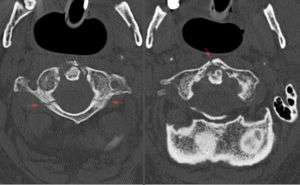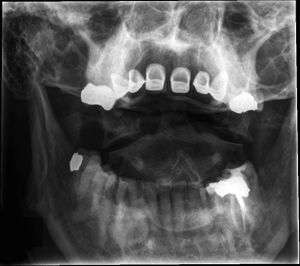Jefferson fracture
Background
- Also known as a C1 burst fracture
- No ligamentous disruption
- Is an unstable spine injury
Clinical Features
- Fracture of the anteterior and posterior arches[1]
- Due to axial loading transmitted through occipital condyles to the lateral masses
- Frequently associated with other cervical fractures
- May be associated with vertebral artery injury[2]

Axial CT scan of Jefferson fracture

Odontoid View
Differential Diagnosis
Evaluation
- Suspect disruption if:
- Lateral x-ray: Increase in the predental space between C1 and dens (>3mm in adults, >5mm in children)
- Odontoid x-ray: Masses of C1 lie lateral to outer margins of articular pillars of C2
- If either of the above findings on x-ray obtain CT C-spine
Management
Prehospital Immobilization
Hospital
- Degree of instability determined by whether or not the transverse ligament is disrupted
- C-collar
- Consult ortho or spine as needed
Disposition
- Admit
See Also
- Spinal Cord Trauma
- Neurogenic Shock
- C-Spine X-Ray
- Unstable spine fractures
- Cervical spine injuries
References
- Jefferson, G. (1919) ‘Fracture of the atlas vertebra. Report of four cases, and a review of those previously recorded’, British Journal of Surgery, 7(27), pp. 407–422.
- Muratsu H, Doita M, Yanagi T et-al. Cerebellar infarction resulting from vertebral artery occlusion associated with a Jefferson fracture. J Spinal Disord Tech. 2005;18 (3): 293-6.
This article is issued from
Wikem.
The text is licensed under Creative
Commons - Attribution - Sharealike.
Additional terms may apply for the media files.